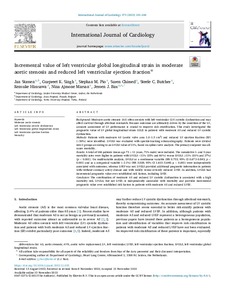Incremental value of left ventricular global longitudinal strain in moderate aortic stenosis and reduced left ventricular ejection fraction
Stassen Jan; Singh Gurpreet K; Pio Stephan M; Chimed Suren; Butcher Steele C; Hirasawa Kensuke; Marsan Nina Ajmone; Bax Jeroen J
https://urn.fi/URN:NBN:fi-fe202301132722
Tiivistelmä
BACKGROUND
Moderate aortic stenosis (AS) often coexists with left ventricular (LV) systolic dysfunction and may affect survival through afterload mismatch. Because outcomes are ultimately driven by the condition of the LV, accurate assessment of LV performance is crucial to improve risk stratification. This study investigated the prognostic value of LV global longitudinal strain (GLS) in patients with moderate AS and reduced LV systolic dysfunction.
METHODS
Patients with moderate AS (aortic valve area 1.0-1.5 cm2) and reduced LV ejection fraction (EF) (<50%) were identified. LVGLS was evaluated with speckle-tracking echocardiography. Patients were divided into 2 groups according to an LVGLS value of 11%, based on spline curve analysis. The primary endpoint was all-cause mortality.
RESULTS
A total of 166 patients (mean age 73 ± 11 years, 71% male) were included. The cumulative 1- and 5-year mortality rates were higher in patients with LVGLS <11% (25% and 60%) versus LVGLS ≥11% (10% and 27%) (p < 0.001). On multivariable analysis, LVGLS as a continuous variable (HR 0.753; 95% CI 0.673-0.843; p < 0.001) and as a categorical variable (<11%) (HR 3.028; 95% CI 1.623-5.648; p < 0.001) were independently associated with outcomes, whereas LVEF was not. LVGLS provided additional prognostic information in patients with/without coronary artery disease and with mildly versus severely reduced LVEF. In addition, LVGLS had incremental prognostic value over established risk factors, including LVEF.
CONCLUSION
The combination of moderate AS and reduced LV systolic dysfunction is associated with a high mortality risk. LVGLS, but not LVEF, is independently associated with mortality and provides incremental prognostic value over established risk factors in patients with moderate AS and reduced LVEF.
Kokoelmat
- Rinnakkaistallenteet [27094]
